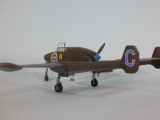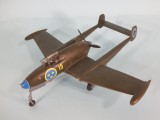Review: Pilot Replicas 1/48 SAAB J21A-3
During the Second World War, Sweden was cut off from the ability to procure modern foreign fighter aircraft as had been done prior to 1940 to equip Flyvapnet, the Swedish Air Force. Thus, it was decided to develop a domestic design for a high performance fighter.
SAAB designer Frid Wänström developed a concept for a fighter powered by a Daimler-Benz V 12 engine. The proposal was a pusher layout with a tricycle landing gear. Conceptually, the design would provide good forward visibility and a heavy armament concentrated on the centerline without having to fire through the propeller, while the tricycle gear would give good landing and takeoff characteristics. The project was approved for development in December 1941, with the designation J21.
After prolonged negotiation, 75 DB605 engines were purchased in 1943, along with a license for Swedish production of the German engine.
The first prototype J 21 flew in July 1943. The design featured a laminar wing and ejection seat for the pilot to insure he cleared the propeller in an emergency. This seat was far more reliable than German seats.
298 SAAB J21s were produced in five production batches, commencing in 1945. The type served from 1946 to 1954. In service, the J21 presented several problems. Due to the pusher design, engine cooling was inadequate, particularly when taxying; this was never adequately resolved, with fighters frequently towed to the runway before startup to limit time for the engine to overheat. The J21 was also not maneuverable enough for the air-to-air role, though it was a good gun platform. Thus, the J21 was converted for ground attack, and the J21A-3 appeared in May 1947, capable of carrying 700 kg of bombs or 8 rocket projectiles. With the new role, the aircraft was designated A21 or B21 in squadron service.
The layout of the J21 allowed its development as the first Swedish jet fighter, with SAAB installing a de Havilland Goblin jet engine in place of the DB 605. The only modification necessary was to raise the horizontal stabilizer to the top of the vertical fin to get it out of the jet exhaust. The aircraft was put into production as the as the J21R.
This kit from Pilot Replicas is the first mainstream injection-molded J 21 ever released in 1/48. Heller did it in 1/72 and Special Hobby have done this and the jet version in 1/72 as well. The kit is fully up to contemporary standards of production design, with petite engraved detail and very light rivet detail. The cockpit has good detail in plastic, with a decal for the instrument panel, and photo-etch detail parts for the seat belts and other small items. The six-part canopy is very clear and can be assembled in either open or closed configuration. Decals are provided for three different J21A-3s are provided.
Due to the excellent production design, this is a very easy kit to assemble. I began by pre-painting the cockpit parts prior to assembly, then went on to assemble the wing, tail booms and tail assembly while waiting for the paint and decals to set up for the cockpit. I then assembled the cockpit and installed it in the fuselage.
I taped the fuselage together and then taped it to the wing to check weight and balance. I ended up filling the nose ahead of the cockpit and above the nosewheel well with flattened fish weights, sufficient to insure nose-sitting. I then glued the fuselage together and then attached it to the wing. Overall fit was good enough that I did not need any putty or other seam filler anywhere.
The J21 came in dark olive green upper surfaces and medium grey lower surfaces. Since I had decided to do the boxart airplane, I first painted the nose and the spinner with Tamiya X-14 Sky Blue, which was close to a dead-on match for the blue in the decals, and then masked them off. I used Tamiya XF-21 (German RLM 71 dark green) for the upper surfaces and XF-66 Light Grey for the lower surfaces. I then gave the model a coat of Future.
I decided to do the boxart airplane, “Blue Caesar”, which was operated by the second division of F 15 Wing 1950-52. The decals went on without any problem. When these had set, I gave the model a coat of Xtracylix clear flat varnish.
I had attached the landing gear during initial assembly, so I now attached the gear doors and wheels. The main wheels look a bit strange, like snowplow wheels, but photos show this is right. The canopy was unmasked and assembled in the open position.
I have been interested in this strange-looking airplane since I first saw photos of it in William Green's “All the World's Aircraft - 1954". This kit by Pilot Replicas delivers the goods with excellent production design and parts that fit easily. The kit is simple, but results in a good-looking model. Highly recommended for anyone interested in offbeat airplanes.

















Tom, that is a good looking model! Looks like they have a winner, there. What the Ascender or the Dutch De Shelde might have been.
I remember the book you mentioned, it was a revelation to me, led me to buy several kits over the years.
🙂 ... Greetings ... 🙂 :
I have always seen this aircraft as one of a peculiar design, but did serve well. This model for sure will benefit greatly from a few figures so the viewer can more grasp the size and design of this aircraft. The base should be round and not one that can offer "GROUND WORK", thus diverting the viewers attention away from the aircraft.
That ( the model ) is a very nice piece, nice work.
Thank you for the pictures.
Yeah this is a helluva nice kit, my kid just got one (he spied it on the shelf and grabbed it before me :)) Nice job on it. Funny how anything with a Diamler Benz looks good, no matter which direction it's going!
Nice looking J-21. I just had my 1/72 Heller kit out of my stash and was contemplating building it. Alas - others trumped it for now, but I will get to it...
A interesting design aircraft reminds me of the Brits Vampire only with a prop.
Two thumbs up.
very cool model
I Like this BUILD !
well I do I plan to purchase PILOT J-21.
In my youth I did Heller 1/72, which is not bad.
Overall, I impress on Swedish aviation.
p.k